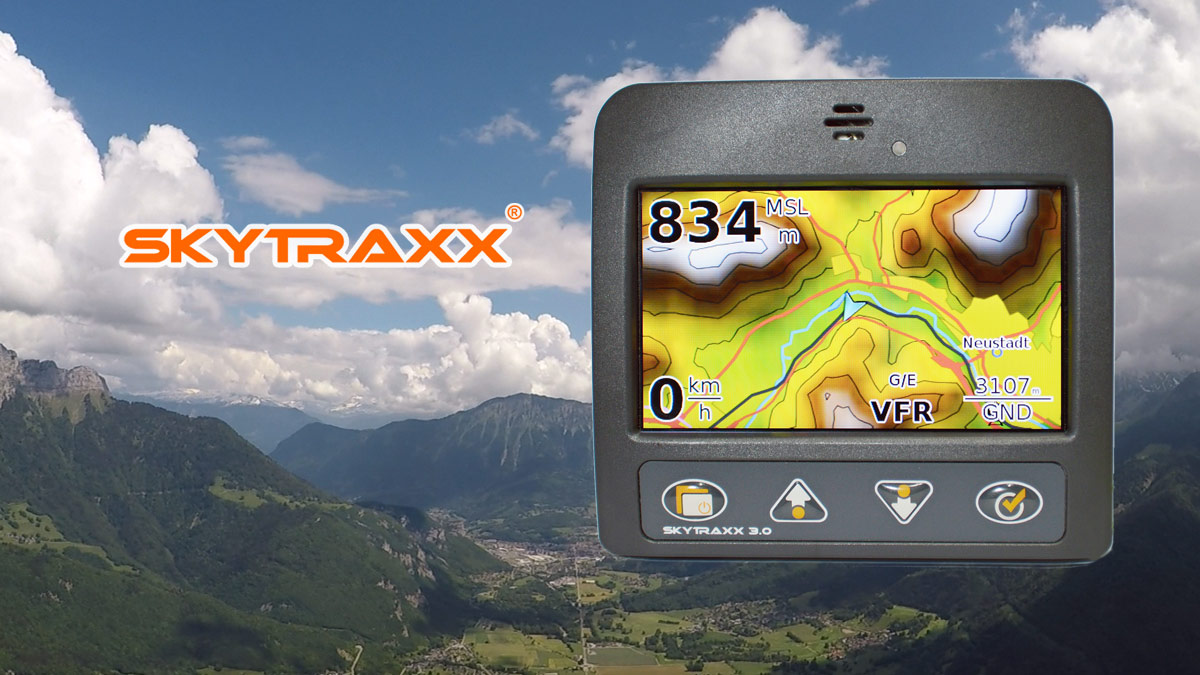
We're always looking out for the best products and keeping an eye on interesting developments. We recently spent some time with Juergen Eckert (Dr.Eng.) at Skytraxx, a smart guy with innovative ideas.
Skytraxx produce well designed and fully-supported flight instruments to a high standard. They are also pioneering live data-sharing services (FANET, see below) and they already have a working solution for FLARM (a way for paraglider pilots to automatically appear on the instrument displays of glider pilots and general aircraft).
Juergen wants instrument manufacturers and software developers to cooperate to make sharing flight information work. Like us, he’s keen to promote safer flying for the freeflight community.
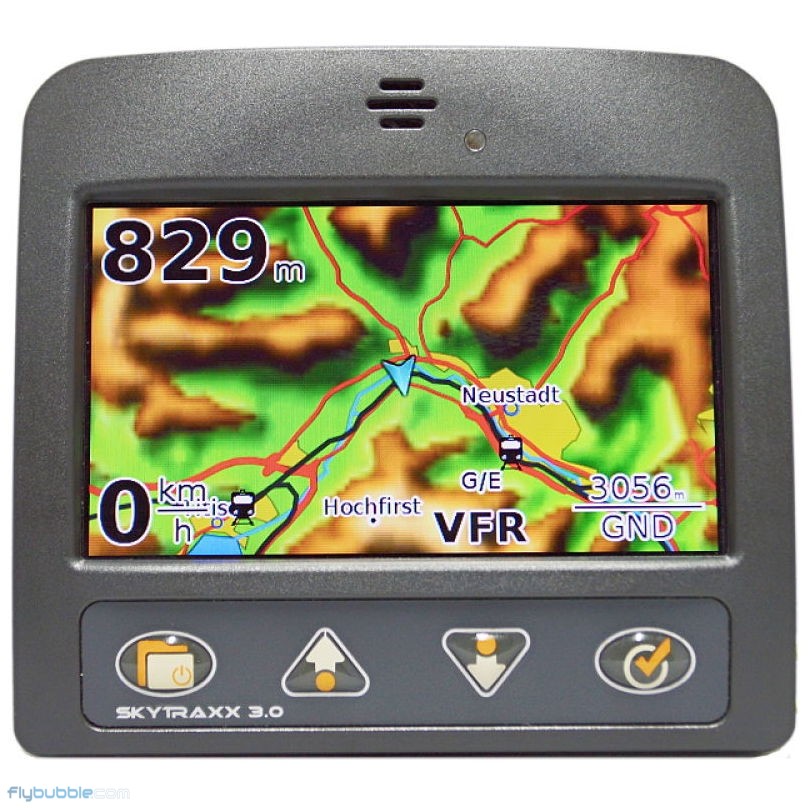
Skytraxx 3.0
An easy-to-use, compact and complete flight instrument with configurable colour display, high-precision sensors, integrated GPS, logger and terrain and airspace maps. It has a very clear screen, an excellent vario, and intelligent design features. Because it’s not a touch screen, the display is brighter and not prone to accidental presses. Operations are via the four raised tactile buttons.
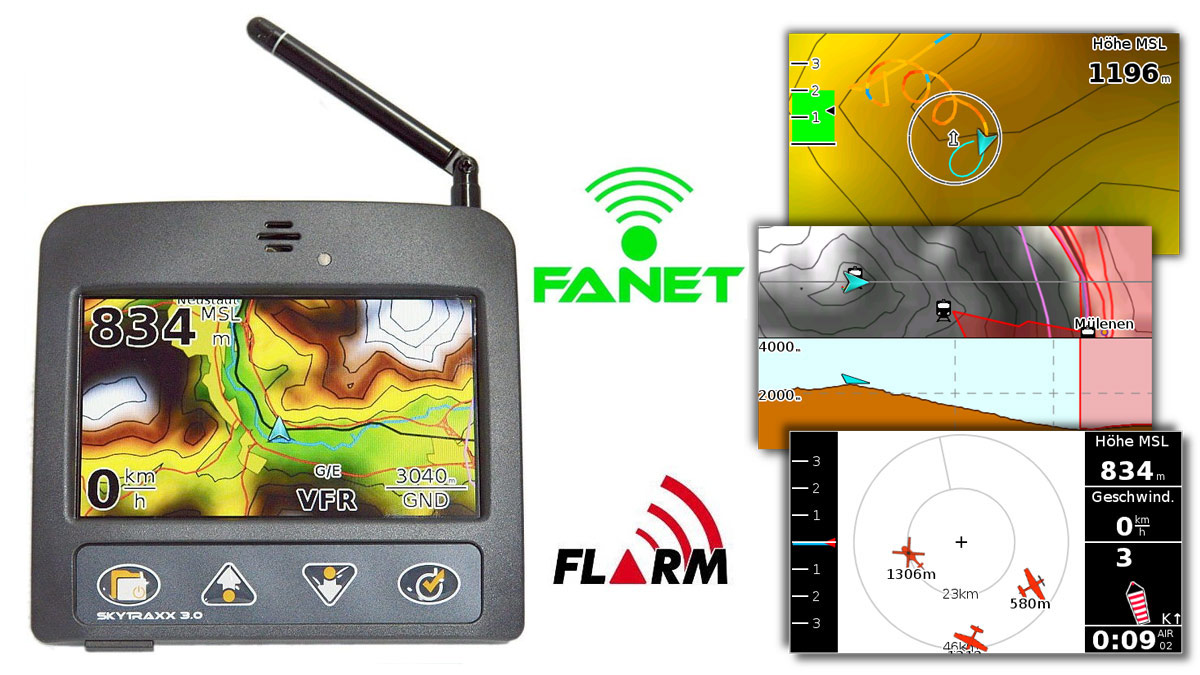
Skytraxx 3.0 FANET+
Add FANET+ (a combination of a FANET transceiver and a FLARM transmitter) capabilities to the Skytraxx 3.0 to unlock the full potential of team flying and safety features. (Find out more about FANET and FLARM below)
(Flybubble Skytraxx 3.0 review)
![]()
Skytraxx Beacon FANET+
The beacon emits your position info over FANET and FLARM, so you can be seen by other paraglider and hang glider pilots on their FANET equipped devices. More important, it's a critical safety feature where sailplanes and helicopters operate. Those will see you on their FLARM devices as well. Additionally it can be used as a cost-effective tracking device.
The integrated storage allows for (signed) IGC log files (up to 45h @ 30sec interval). Consider it as a backup logger. Live tracking pages can be found on http://live.glidernet.org or http://glidertracker.de/ and many more. However this requires an Open Glider Network (OGN, see below) base station in range (or another Skytraxx 3.0 with an internet connection (WiFi))
OGN can forward to LiveTracking24 if you register in both platforms and enable data forwarding.

Skytraxx Tweety
A super-light, super-simple audio-only vario for Hike & Fly, backup and simplicity. Battery operated, running time approximately 250 hours.
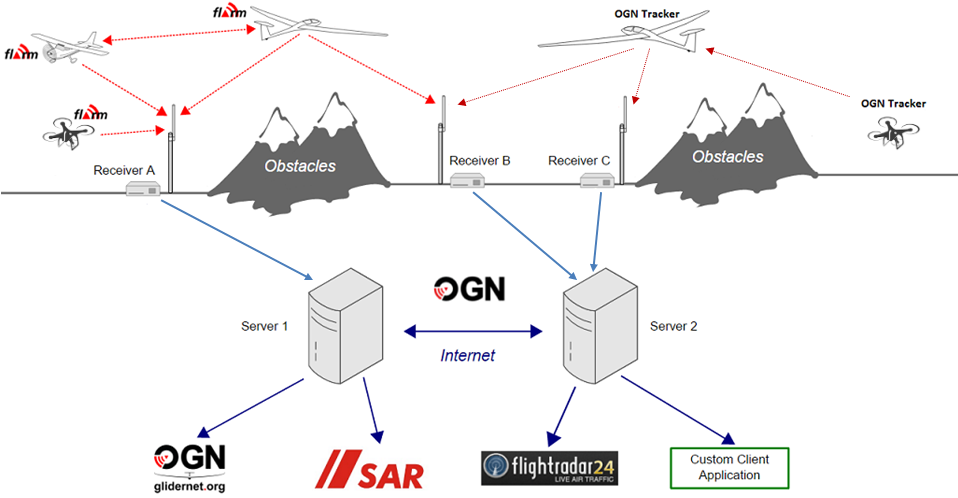
What is the Open Glider Network?
The objective of the Open Glider Network (OGN) is to create and maintain a unified tracking platform for gliders, drones and other aircraft. Focused on tracking aircraft equipped with FLARM and OGN trackers, OGN is also open for integrating of other data sources (e.g. PilotAware, SPOT, FANET, etc.) The tracking data is freely available to anyone as long as they follow OGN data usage rules.
What is FLARM?
Flight-Alarm (FLARM) is well known in the glider and powered aircraft domain. Based on accurate GPS position information and various other techniques it can reliable predict a flight trajectory. This information is encrypted, broadcast and used to aid in collision risk calculations. More than 30,000 manned aircraft and many Unmanned Aerial Vehicles (UAVs) are equipped with FLARM today. In Europe almost 100% of the gliders are equipped with FLARM.
Skytraxx flight instruments with built in FANET also include FLARM. All FLARM equipped gliders, helicopters or powered aircrafts can detect the device at a very early stage and plan their flight path in order to avoid a collision.
Note that only a FLARM beacon is included in the Skytraxx devices, so a bigger device in an aircraft is required to see you, and you don't ‘see’ anyone except those on FANET in realtime. It helps other aircraft avoid you (which, in increasingly busy skies, has to be a very good thing!).
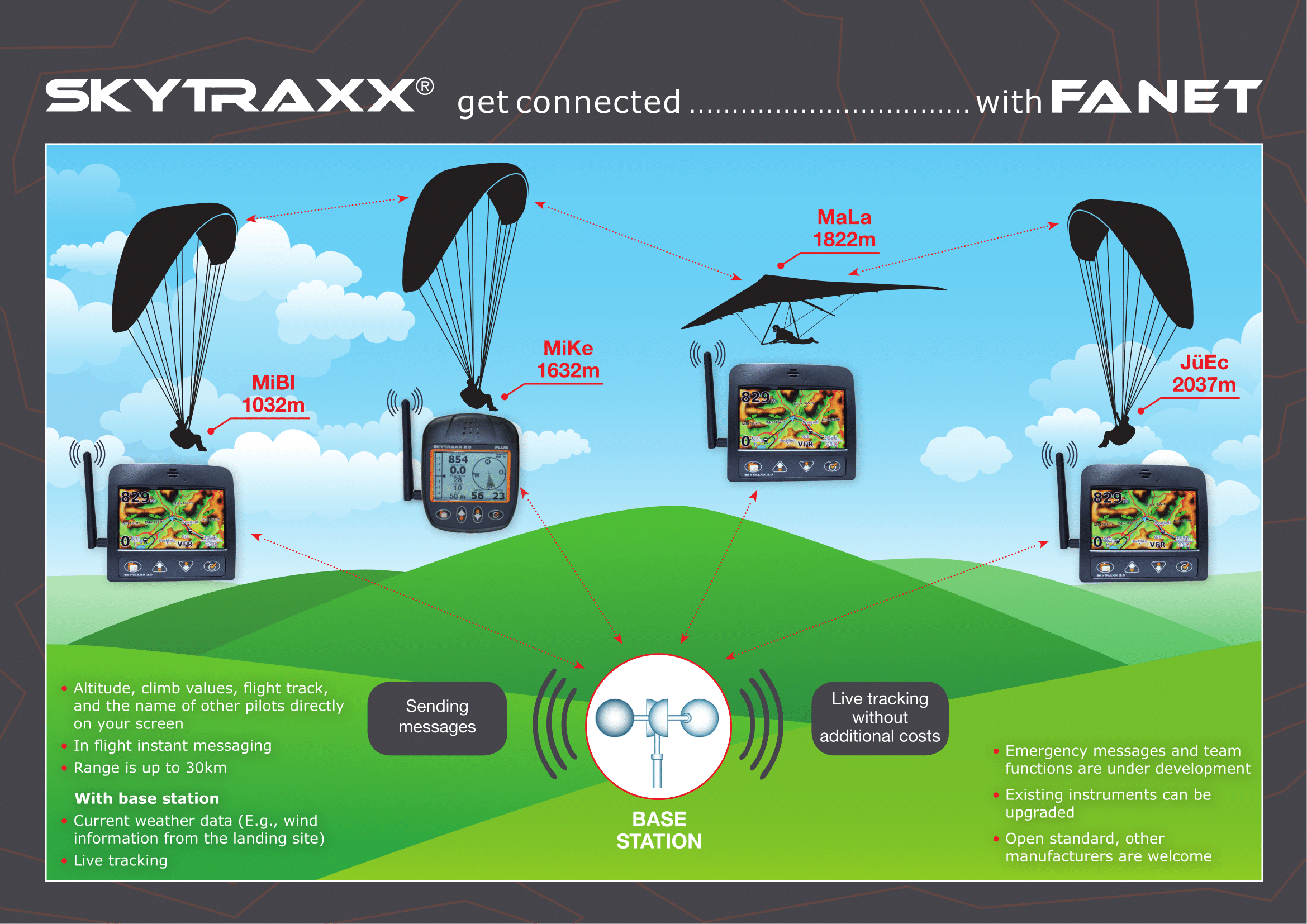
What is FANET?
The "Flying Ad-hoc Network" (FANET) offers the ability to automatically interconnect flight instruments without the need of any infrastructure. It is intended to be an open standard which operates worldwide on a license-free radio frequency. A pilot on FANET can see other FANET pilots’ data on their instrument (assuming they’ve opted to share information).
Pilots using FANET act as relays and forward information. The communication distance of up to 20km (12 miles) automatically gets doubled once any intermediate glider is present. Up to 86km has been observed, so it won’t take many pilots to create an effective network.
To expand the capabilities, additional base stations can be set up to exchange data with the instruments. Those stations will typically be placed close to take-off and landing sites and are able to share wind information and forward position information for live-tracking to the internet. Free live tracking is currently available via more than 300 Open Glider Network (OGN) base stations, more are being added all the time.
Wherever the FANET links onto a base station or another Skytraxx 3.0 connected to the internet, all the positions of pilots within the FANET become revealed to the Open Glider Network.
Added benefits
The main advantage is being able to keep track of your fellow FANET users, without needing a mobile phone data signal.
A rescue helicopter would typically have a FLARM receiver, so could see your position if they know your rough location or user ID. Airborne paragliders or other aircraft could be informed from the ground via rescue messages to keep the air space free.
FANET has many more possibilities. The system is not limited to Skytraxx devices, and Juergen is discussing developments with other manufacturers of variometers and weather stations. The future is exciting!

Flybubble: How is this different to other ‘position sharing’ solutions?
Juergen: “In general you have to distinguish here between 2 groups: internet connected ‘position sharing’ and non-internet-connected ‘position sharing’ (adhoc). Sure you can inter-connect both, but for simplicity let’s look at them separately.
For the former one we decided---instead of going with yet another closed system---to go with the biggest open system, OGN (which ironically collects most of its information with base stations from an adhoc network). So we have a manufacturer independent system.
For the latter case we had to come up with something new as no other suitable system existed. FLARM is encrypted and requires a license. We made this standard open so everybody can join in. FANET is about 1 year old and already has more than 2000 nodes.”
For us it’s more important that the pilots can see each other no matter which manufacturer they are using. Rather than: ‘Too bad, I have a X-brand. You’ll only be able to see me if you buy a device from the same brand…’ There is not the slightest doubt that a Boeing can see Airbus planes and vice versa. This has to be the same in the paragliding market! We need open standards! --- Juergen Eckert
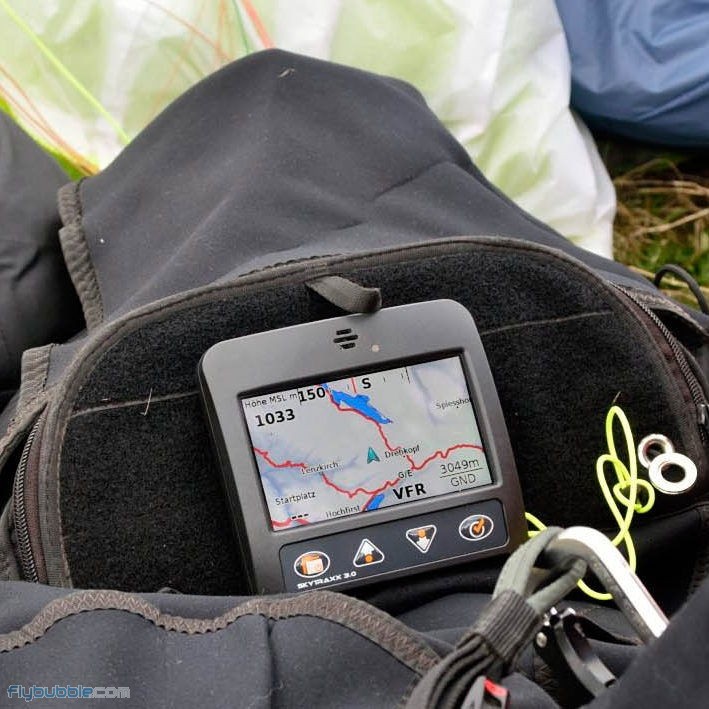
Alternative technologies
Naviter offers some traffic info on the Oudie 4 but this relies on your mobile phone app Oudie Live being connected to mobile data. It shares your position on the Open Glider Network, and you can see all traffic that is reporting to the OGN (slightly delayed due to using the internet). Your predefined ‘buddies’ appear more prominently.
Although the Skytraxx 3.0 is designed to take advantage of FANET using the radio signal you can broadcast your position to the Open Glider Network using your Skytraxx with a Wifi stick and a mobile hotspot. Then you can see Naviter devices on Skytraxx devices and vice versa if both have an internet connection. This is independent from FANET.
When Naviter integrate FLARM into their devices they will offer FANET.
FLARM but no FANET
The Flytec 6030 can currently have a FLARM (beacon) installed by Naviter or Volirium.
Volirium are planning to integrate FLARM technology in the Volirium P1.
No FLARM no FANET
Assuming you have continuous mobile data, FlySkyHi (iOS) and XCtrack (Android) offer simple team flying capabilities. Livetrack24 shows other pilots who are busy using livetracking. Flymaster have their own proprietary live tracking system which uses the cellphone networks. You can view all pilots’ positions on the live tracking website.
Brought to you by Flybubble
Like what we do? The best way to thank and support us is to buy gear from us and recommend us to others. Review our service on Trustpilot and our products on Flybubble Shop. You can also subscribe to Flybubble Patreon. Thank you!

